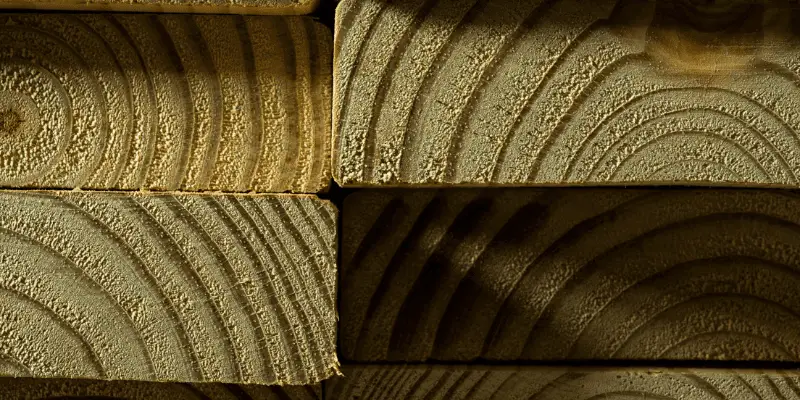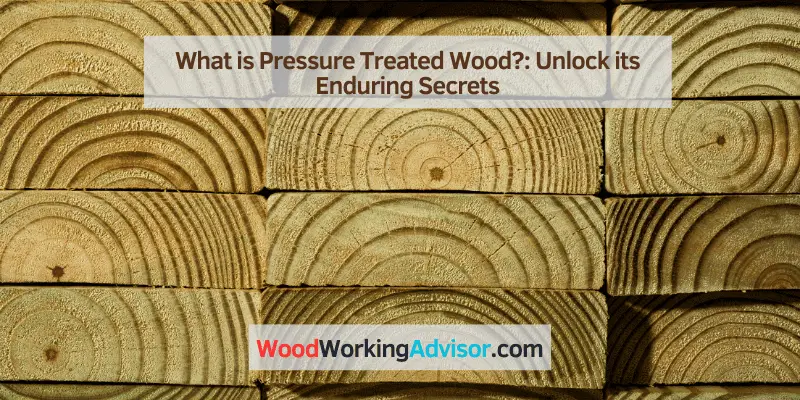Pressure treated wood is lumber that has been infused with chemical preservatives. These chemicals protect it from rot, decay, and insect damage.
Pressure treated wood stands as a durable and cost-effective choice for outdoor projects like decking, fences, and landscaping. The treatment process involves placing wood in a depressurized holding tank which removes the air and replaces it with a preservative solution.
This method ensures deep penetration of the chemicals into the wood fibers, significantly extending the material’s life by guarding against environmental stressors. Often identified by its greenish tint, pressure treated wood is tailored to withstand the elements, making it an ideal material for outdoor construction where exposure to moisture and pests is a constant challenge. The ability to resist decay keeps pressure treated wood serviceable for many years, ensuring a sound investment for homeowners and builders alike.
The Essence Of Pressure Treated Wood
Pressure treated wood refers to lumber that has been impregnated with chemical preservatives to protect it from rot, decay, and insect damage. This process involves placing wood in a depressurized holding tank which removes the air and replaces it with a preservative solution, ensuring deep penetration into the core of the wood.
The process of pressure treating wood has roots dating back to the 1940s, originally developed to extend the life of exterior woods and safeguard them against harsh environmental conditions. The technique was rapidly adopted due to its effectiveness and has since become a staple in outdoor construction projects, including decks, fencing, and landscaping.
In contemporary building projects, pressure treated wood remains a popular choice due to its durable nature and ability to withstand mother nature. From residential homes to commercial structures, its ubiquity stands as a testament to its proven track record, ensuring long-lasting performance in a multitude of applications.
Composition And Treatment Process
Pressure treated wood is a form of timber that has been impregnated with chemical preservatives to protect it from decay, insects, and fungal infection. It is particularly suitable for outdoor applications where durability is crucial. Different species of wood can be pressure-treated, albeit the most common include pine, fir, and hemlock due to their availability and inherent properties that complement the treatment process.
The treatment process involves several steps to ensure the wood’s longevity and efficacy. Initially, wood is placed in a large vacuum chamber which removes air and moisture from the wood cells. Then, a preservative solution is introduced, and high pressure is applied to force the chemicals deep into the wood fibers. After a sufficient retention period, the treated wood is removed and left to dry.
Handling pressure-treated wood necessitates certain safety measures to avoid exposure to the chemicals used during the treatment. Workers are advised to wear protective clothing, gloves, and safety goggles. Additionally, it is important to work in well-ventilated areas and to wash exposed skin areas promptly after contact with treated wood.
Benefits Of Using Pressure Treated Wood
The use of pressure treated wood introduces a host of benefits that enhance both its performance and environmental impact. With a focus on improved longevity, this type of wood undergoes a treatment process that imbues it with resistance to deterioration, common when exposed to harsh elements. This directly translates to a longer lifespan, reducing the need for frequent replacements.
Resistance to rot and pests is another significant advantage. Pressure treated wood is less susceptible to the damaging effects of moist environments and is well-armed against the threat of termites and other wood-loving insects. This protective barrier extends the functional life of wood structures considerably, favoring both cost savings and maintenance ease.
From an ecological perspective, the recycling potential and eco-friendliness of pressure treated wood are compelling. By favoring the utilization of treated wood, there is a marked decrease in the consumption of raw materials. This sustainable approach underscores the importance of recycling and supports environmental conservation efforts, making pressure treated wood an eco-conscious choice for construction and building projects.
The Science Behind Preservation
Pressure treated wood is enhanced with preservative agents to resist decay, insects, and fungal infection. This treatment involves infusing the wood with chemicals that permeate the wood fibers, creating a robust barrier against environmental deterioration. The interaction with wood fibers is critical as it ensures the preservatives are deeply embedded, providing long-lasting protection.
The long-term effects on wood properties include an increased lifespan and the ability to withstand harsh outdoor conditions. Despite these benefits, treated wood may exhibit changes in color, texture, or form over time due to the preservatives used. Nevertheless, the structural integrity of pressure treated wood remains uncompromised, making it a durable choice for construction and outdoor applications.
Maintenance And Working With Treated Wood
Safety precautions for handling pressure treated wood are imperative to maintain good health and safety. Always wear gloves, long sleeves, and a mask to prevent skin contact and inhalation of sawdust. Ensure the work area is well-ventilated, especially during cutting or sanding, which can produce harmful particles.
For cutting and installation, using the right tools is key. Equip saws with blades designed for treated wood to minimize splintering and ensure clean cuts. Pre-drilling holes for fasteners can prevent splitting and allow for a more secure attachment. Keep tools clean to avoid corrosion from the chemicals in treated wood.
Long-term maintenance is crucial for preserving the integrity and appearance of treated wood. Conduct annual inspections for signs of wear or damage. Clean the wood with a mild detergent and apply a water repellent finish every two to three years to protect against moisture. If refinishing is necessary, sand the surface before applying a coat of stain or sealant recommended for treated wood.
Common Uses In Construction And Landscaping
Pressure treated wood is widely utilized for a variety of construction and landscaping purposes. Its resistance to decay and insects makes it a preferred choice for outdoor structures like decks, fences, and playground sets. Within the residential sphere, it’s often used to craft garden beds, picnic tables, and benches. Notably, this material is just as valuable in commercial settings—implemented in public boardwalks, piers, and support structures for overhead vegetation.
For those who seek a touch of creativity, pressure treated wood lays down the foundation for unique outdoor projects such as custom gazebos, arbors, and trellises. Given its versatility, it is imperative to select the appropriate type of treated wood that matches the specific environmental conditions and usage requirements of your project. Aspects such as wood species, treatment chemicals, and retention levels should be carefully evaluated to ensure the longevity and safety of the construction.

Avoiding Common Misconceptions
Pressure treated wood often falls victim to misinformation. A common myth suggests that treated wood contains harmful chemicals that can leach into the environment, but modern methods ensure a more controlled and safer use of preservatives. Contrary to the belief that treated wood is less durable, it has been shown to withstand environmental elements far better than untreated options, thereby prolonging its life and reducing the frequency of replacement.
Many homeowners worry about the environmental impact of using pressure treated lumber. It is important to recognize that the preservation process is designed to minimize environmental damage. The treated lumber industry continuously works on improving the eco-friendliness of its products, countering deforestation by reducing the need for frequent wood replacement.
| Treated Wood | Untreated Wood |
|---|---|
| Enhanced durability | More susceptible to decay |
| Reduced maintenance costs | Higher maintenance and replacement frequency |
| Eco-friendly advancements | Greater environmental impact over time |
Innovations And Future Of Treated Wood
Recent advancements in treatment techniques have significantly boosted the durability and lifespan of pressure treated wood. Modern processes now incorporate micronized copper compounds, enhancing the wood’s resistance to decay and termites. Engineers and scientists are collaborating to further refine these treatments to be more effective and environmentally friendly.
The pursuit of sustainable alternatives is shaping the future trends of treated wood. Bio-based preservatives and non-toxic methods are among the innovations gaining traction. These eco-friendlier solutions strive to deliver the same level of protection without using traditional chemicals.
| Implication | Influence on Construction Industry |
|---|---|
| Enhanced Durability | Leads to longer-lasting structures with reduced maintenance costs. |
| Eco-friendly Treatments | Supports green building initiatives and can contribute to LEED certification. |
| Cost Efficiency | Minimizes the long-term expenses associated with wood preservation. |
Frequently Asked Questions For What Is Pressure Treated Wood
What’s The Difference Between Pressure Treated Wood And Regular Wood?
Pressure treated wood has been chemically treated to resist rot, insects, and moisture, unlike untreated regular wood which doesn’t have these protective properties.
Why Not To Use Pressure Treated Wood?
Pressure treated wood contains chemicals that can be harmful to health and the environment, and it’s not suitable for indoor use or surfaces that come into contact with food.
What Are The Disadvantages Of Pressure Treated Wood?
Pressure treated wood can release harmful chemicals, may warp or shrink over time, and often requires regular maintenance. It’s also not suitable for indoor use due to potential health risks.
Does Pressure Treated Wood Need Treating?
Pressure treated wood is pre-treated for resistance to decay and insects. It generally does not require initial additional treatment but may need maintenance over time to uphold its durability.
Conclusion
Wrapping up, pressure treated wood stands as a durable and cost-effective choice for outdoor projects. It resists decay, insects, and weathering, extending the life and beauty of wooden structures. For those prioritizing longevity and strength in their constructions, this treatment process is worth considering.
Always remember to handle with care and follow safety guidelines.



7 thoughts on “What is Pressure Treated Wood?: Unlock its Enduring Secrets”